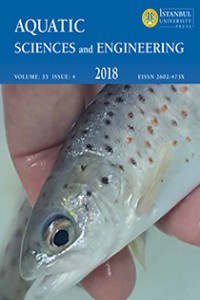Behavior and Stereotypies of Nile Tilapia (Oreochromis niloticus) in Response to Experimental Infection with Aeromonas hydrophila
Abstract
DOI: 10.26650/ASE2018407191
Motile Aeromonas septicemia (MAS) is a common
bacterial fish disease that may cause severe economic losses. This novel study
was conducted to investigate behavioral changes of Nile tilapia (Oreochromis
niloticus) in response to experimental induction of MAS. Aeromonas hydrophila,
which is the causative agent of MAS, was isolated from diseased O. niloticus
and used for the experimental infection of O. niloticus by intraperitoneal and
intramuscular injections for inducing MAS. Each injection route had its control
group. Fish behavior was recorded daily using a digital video camera for 7
consecutive days post injection in intraperitoneally and intramuscularly
injected fish. On day 14 post injection, the behavior of intramuscularly
injected fish was recorded again. Experimentally infected O. niloticus showed
various clinical signs such as exophthalmia, ocular hemorrhage, congested
gills, and skin and fin hemorrhages. The behavior of apparently healthy and
experimentally infected O. niloticus was recorded and analyzed by scan
observation. The experimentally infected fish exhibited cessation of normal
behavior. Buccal-opercular movement and signs of aggression increased, whereas
foraging, schooling, and shoaling frequencies decreased. Two abnormal
behavioral patterns (stereotypies) of apparently healthy O. niloticus following
injections were recorded. Post injection, intraperitoneally injected fish
performed circular swimming on day 3 and 7, whereas intramuscularly injected
fish exhibited vertical movement on the days 4, 5, 7, and 14. The frequency of
circular swimming increased over time; however, vertical swimming frequency
decreased by day 14. These results revealed that MAS had a severe effect on the
behaviors of apparently healthy fish. Therefore, monitoring the behavior of O.
niloticus may provide a useful and noninvasive tool for assessing fish health
and diagnosing MAS early.
References
- Martins,C.I., Galhardo, L., Noble, C., Damsgård, B., Spedicato, M.T. Zupa, W. & Kristiansen, T. (2012). Behavioural indicators of welfare in farmed fish. Fish physiology and biochemistry journal, 38(1), 17-41. DOI: 10.1007/s10695-011-9518-8Almaza´n-Rueda P,
Abstract
References
- Martins,C.I., Galhardo, L., Noble, C., Damsgård, B., Spedicato, M.T. Zupa, W. & Kristiansen, T. (2012). Behavioural indicators of welfare in farmed fish. Fish physiology and biochemistry journal, 38(1), 17-41. DOI: 10.1007/s10695-011-9518-8Almaza´n-Rueda P,
Details
| Primary Language | English |
|---|---|
| Journal Section | Articles |
| Authors | |
| Publication Date | November 2, 2018 |
| Submission Date | March 16, 2018 |
| Published in Issue | Year 2018 Volume: 33 Issue: 4 |
Cite
 Open Access Statement:
Open Access Statement:
This is an open access journal which means that all content is freely available without charge to the user or his/her institution. Users are allowed to read, download, copy, distribute, print, search, or link to the full texts of the articles, or use them for any other lawful purpose, without asking prior permission from the publisher or the author. This is in accordance with the BOAI definition of open access.


